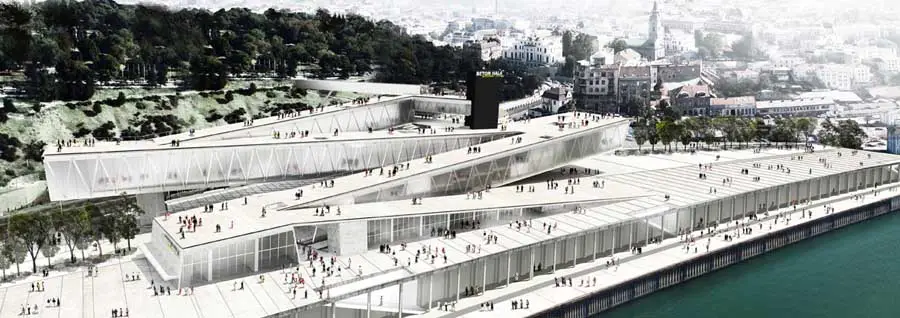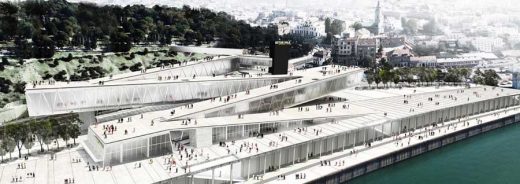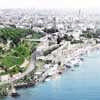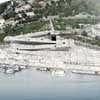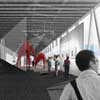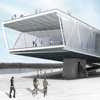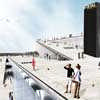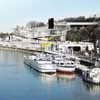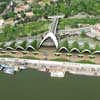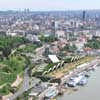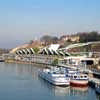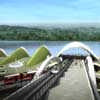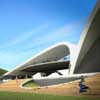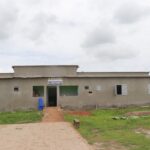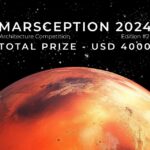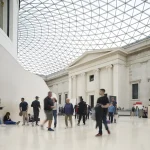Beton Hala Waterfront Center Belgrade building, Serbia architecture project design architect
Beton Hala Waterfront Competition, Belgrade
Architecture Contest Serbia – design by various architects
post updated 28 May 2025
Design: dRN Architects, Santiago, Chile
17 May 2011
Beton Hala Waterfront Center Competition Entry by dRN
dRN Architects Directors: Nicolas del Rio, Max Nuñez
Associate architect: Marcial Hernandez
Team: Marine Winckler, Sebastian Cruz, Alfredo Thiermann
Introduction
The design for the BHWC building starts off by acknowledging the importance of the existing Beton Hala structure not only as a significant continuous building clinging over the riverbank, but as an urban platform from which to relate to several essential city attractions.
The elongated rhythmic shape portrayed by the existing BH structure and the site itself suggests to us the use of extended horizontal volumes, which are proposed as piled ascending ramps. The building will become a new architectural landmark in Belgrade housing, in a single iconic structure, a multi-programmatic edifice and perhaps more importantly will become a dynamic hub for visitors.
A superior pedestrian connection between the river front, the platform (the Park where BHWC is embedded) and the Fortress level is a decisive goal of our project.
Beton Hala Waterfront Center Competition Entry by sanzpont
Design: sanzpont [arquitectura], Belgrade
Arches from the Past & Green Slopes into a new Sava River Icon
Concept of Design:
Inspiration comes from the Site
Arches of the Belgrade Fortress
have been reinterpreted to form a modern and iconic arcade linking the past with the present and future.
The Green Slopes from Kalemegdan Park
have been the main inspiration for creating a green building to expand the city’s natural landscape.
Sava River Waveforms
spread inland to create an elevated panoramic walkway integrated with the existing building.
Beton Hala Waterfront Center Competition Entry by EGA_Erik Giudice
Design: EGA_Erik Giudice Architects
An open landscape for Belgrade
Beton Hala is today an open and spontaneous cultural hub. The new building assumes this identity and provides more space for spontaneity and creativity.
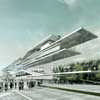
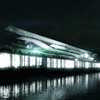

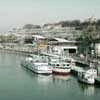
images from EGA_Erik Giudice Architects
The layout for the Waterfront Center takes it’s departing point from the linear structure of the existing Beton Hala. By concentrating the program on a linear strip, a park is created towards the Castle and a large multi activity promenade along the river.
The new structure is highly transparent, letting through views from the river towards the Castel and from the Castel towards the river. The structure becomes a transparent filter between two complementary urban public spaces: the park and the river promenade. On ground level several outdoor pedestrian passages connect the park and the promenade.
The building adds a vertical dimension to the horizontality of the site, reflecting the multifaceted and diverse identity of Belgrad and its cultural life. The building becomes a stage for multiple expressions.
Through its linear layout the building leaves a generous space for open-air activities in particular for exhibitions, concerts, events. The buildings elevations become the visual and acoustical backdrop for the open-air stages that can be located on its two sides.
The building is designed as a vertical public space, with large open air ramps that makes it possible to reach the top level, the viewing platforms and the connecting bridge to the castle without entering the commercial functions.
Two outdoor promenades goes through the building, while the urban landscape progressively unveils. The promenades culminates on the top terrace with a spectacular view on the river and the Belgrade skyline.
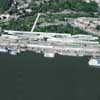
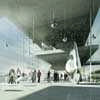
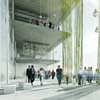
images from EGA_Erik Giudice Architects
An Icon for Belgrade
The dynamic expression of the Center adds a new icon to the Belgrade waterfront.
The building’s materiality creates a powerful contrast between the exposed smooth concrete and the crystalline glazed envelope. The enclosures are transparent and reflecting, dematerializing the limits between inside and outside.
The building is an efficient engine, it’s structural design and it’s open plans gives an unlimited flexibility in time and space. Movable and sliding facades and partition walls make it possible to unite or separate spaces according to the needs of each function, event and program. The buildings structure is conceived as a flexible shelf that can accommodate a great variety of functions both cultural and commercial.
The exhibition spaces are concentrated in the north-western part of the structure, as the rest of the building they are characterized by a high degree of flexibility. Depending on the type of exhibition the exterior walls will either be opaque or transparent. The terraces that are connected to the exhibition spaces can be used for outdoor exhibitions and related events.
The commercial spaces are located in the south eastern part of the structure. These spaces can be subdivided in several independent units in order to obtain a great degree of flexibility in it’s uses and to respond to the needs of a wide variety of commercial activities such as cafés, restaurants, shops etc…
The building has several natural auditoriums through its inclined surfaces and ramps. Movable acoustic deflectors and stage sets make it possible to adapt these spaces for musical or theatrical performances.
The identity of the building as a support for ephemeral events is integrated in the building’s design. The building is conceived as a toolbox for the users, visitors and artists.
Technical description – Sustainability and energy concept
By stacking the functions, the building’s footprint is reduced, which gives place to a large green park, contributing in an essential way to the sustainability of the project.
The exposed concrete structure gives a high inertia to the building which acts as a thermal regulator: storing heat during winter and coolness during summer.
The interior spaces are protected by a double envelope that acts as an efficient thermal buffer, using passive means to reduce the energetic needs of the building.
High quality double glazing creates an efficient thermal skin. The slabs have a integrated insulation which provides total continuity in the insulating envelope.
During cold periods the double skin provides a powerful insulation and reduces the need for heating. Through the glazed envelope the sun provides passive heating.
In intermediate periods with good climatic conditions the sliding glass facades can be opened and the interior spaces benefits from natural ventilation.
During hot periods the space between the two envelopes is ventilated and integrated, mechanized textile sun screens between these two envelopes protect the interior from the sun radiation, keeping the coolness. During the night a free-cooling system is adopted, using the high inertia of the concrete structure to store coolness that is progressively restored during the day.
Project
Entry international competition Beton Hala Waterfront
Location
Belgrade, Serbia
Surfaces
Museum: 5,000 m2
Commercial spaces: 6,000 m2
Parking: 23,000 m2
Exterior spaces:
Park: 8,600 m2
Promenade: 9,700 m2
Team
EGA_Erik Giudice Architects
Erik Giudice Architect, Federico Mannella Architect, Lars Almgren Assistant Architect
Beton Hala Waterfront Center Competition Belgrade images / information from EGA_Erik Giudice Architects
Beton Hala Waterfront Competition – Winners
TWO EQUAL FIRST PRIZES (award of 25.000,00 EUR each):
Authors: Team “ARCVS”: Branislav Redžić, Dragan Ivanović, Zoran Milovanović, Zoran Đorović, Vesna Milojević, Boris Husanović, Marko Todorović, Predrag Stefanović, structural consultant: Sreto Kuzmanović
Authors: Sou Fujimoto Architects, consultant Ove Arup Japan
TWO EQUAL THIRD PRIZES (award of 7.500,00 EUR each):
Authors: Dejan Miljković, Jovan Mitrović, Aleksandar Rodić, associates: Miloš Milivojević, Vuk Lukić, Dejan Mitrović, Aida Hadžiahmetović, Iva Olujić
Authors: MX_SI architectural studio, Boris Bežan, Hector Mendoza Ramirez, Mara Gabriela, Partida Muňoz, Oscar Espinosa, Olga Bombač
Location: Beton Hala, Belgrade, Serbia
Architecture in Serbia
Contemporary Architecture in Serbia
Information on a recent Serbian Design Competition:
Centre for the Promotion of Science in Belgrade Architecture Contest
Centre for the Promotion of Science in Belgrade
CFPS Building Belgrade
Sadar+Vuga
Southeast Europe Building Design
Southeastern Europe Architecture Designs – selection from e-architect:
Bosnia and Herzegovina Buildings
Comments / photos for the Beton Hala Waterfront Center Competition Serbia page welcome
Website: visit Belgrade

